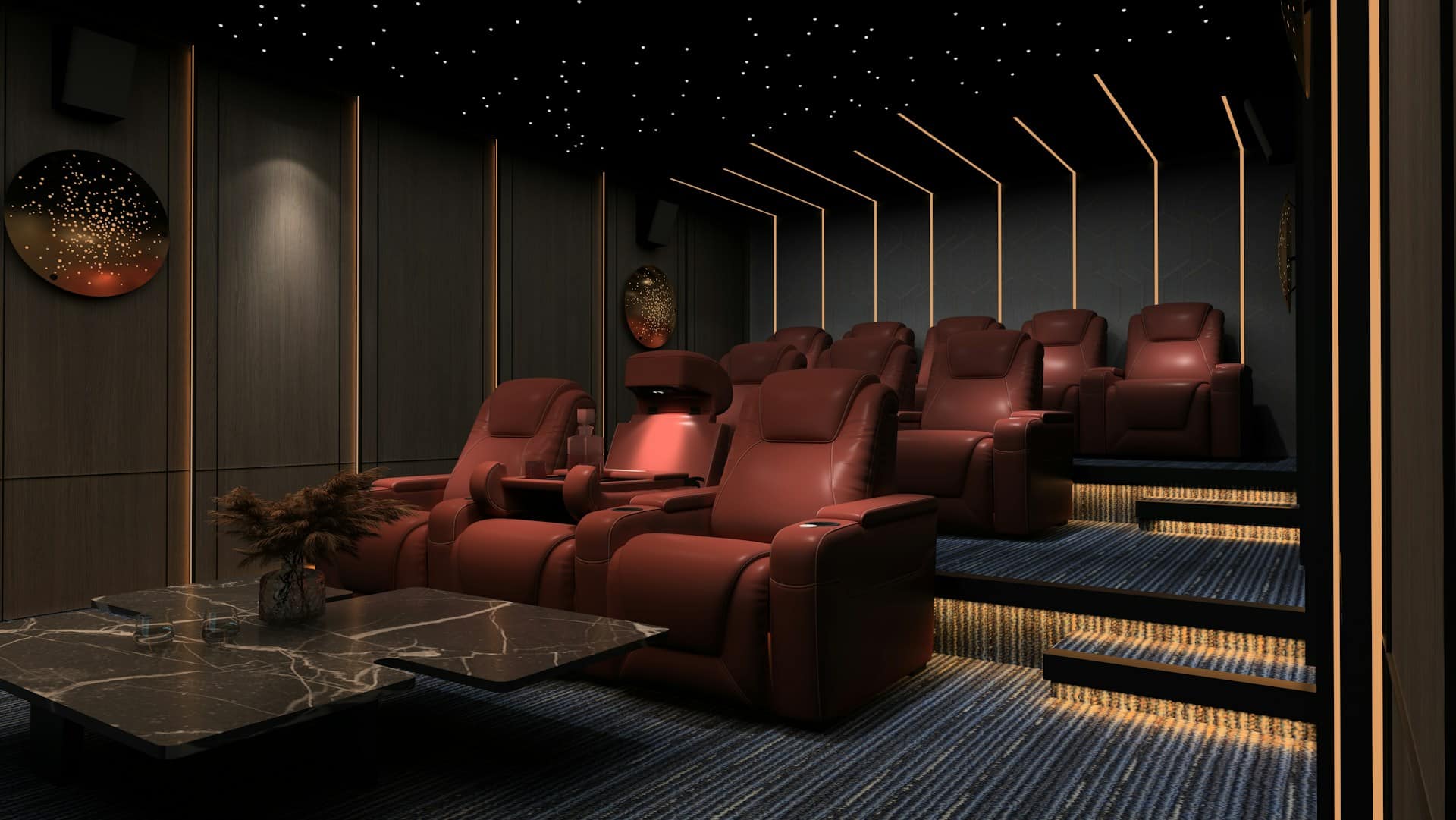Home theaters represent a unique blend of entertainment and luxury, providing an exceptional movie-going experience without leaving the comfort of your home. However, creating the perfect home theater isn’t just about buying the latest equipment. It requires careful planning and design to optimize sound quality, visual experience, and overall comfort. As you venture into creating a cinematic experience at home, consider these top design tips that will transform your ordinary room into an extraordinary home theater.
Selecting the Perfect Room
When creating a home theater, the first step is to select the ideal room. Not every space in your home is suitable for a theater setup. The room’s size, shape, and location can significantly affect the audio and visual quality of your cinema experience.
A lire aussi : What are the best acoustic panels for a UK home recording studio?
A rectangular room is an excellent choice for a home theater because it allows for optimal sound distribution. Avoid rooms that are square or have irregular shapes, as they can create audio distortion. The room should also have minimal windows and doors to reduce light and sound leakage.
The size of the room will influence the type of equipment you need. Larger rooms require more powerful speakers and a larger screen to maintain a high-quality visual and sound experience. Conversely, smaller rooms need less powerful equipment.
Dans le meme genre : How can you design a UK formal living room that is also family-friendly?
Finally, consider the room’s location in your home. Basements are typically good choices because they provide the necessary darkness and quiet, but other spaces can also work well with some design modifications.
Installing the Right Home Theater System Equipment
After you’ve chosen the room, the next step is to install the right home theater system equipment. The equipment you choose will significantly affect the quality of your audio and visual experience.
For the visual aspect, a larger screen is desirable. But remember to consider the room’s size; a screen that’s too large can overwhelm a small space and vice versa. The screen should be at a comfortable viewing distance from the seating area – too close and it may strain the eyes; too far and it might lose impact.
Sound is just as important as the visuals in a home theater. A high-quality surround sound system can provide a real cinematic experience. Consider a 5.1 or 7.1 surround sound system; these include several speakers that are placed around the room to create a three-dimensional sound experience.
Remember that not all equipment is created equal. It is crucial to invest in higher quality equipment that will last longer and provide a better overall experience.
Optimizing the Room’s Acoustics
A home theater’s sound quality is not only dependent on the audio equipment but also on the room’s acoustics. A room with good acoustics will enhance the sound, while a room with poor acoustics can distort it.
Hard surfaces, such as tiled floors or brick walls, reflect sound, which can cause echoes and make the audio seem harsh. To prevent this, consider adding carpeting or rugs and installing acoustic panels on the walls. These materials absorb sound and prevent unwanted echoes.
The positioning of your speakers also impacts the room’s acoustics. Speakers should be placed at ear level and angled towards the seating area to provide the best sound quality.
Designing Comfortable Seating and Lighting
Comfort is a crucial element in the design of a home theater. No matter how good your audio and visual setup is, if your seating is uncomfortable, it will detract from the overall experience.
For the best comfort, consider installing proper home theater seats. These seats can be individual chairs or a larger sofa, depending on your preference and the room’s size. Ensure they are padded and offer good back support for those long movie marathons.
Lighting is another critical aspect of a home theater’s design. While the room should be dark enough to provide a good visual experience, some lighting will be needed. Dimmable lights or LED strip lights can provide sufficient lighting without detracting from the screen’s visibility. Where possible, avoid lights that shine directly onto the screen as they can cause glare.
Ensuring Proper Ventilation
When designing a home theater, it’s easy to overlook the room’s ventilation. A lack of proper ventilation can make the room feel stuffy and uncomfortable, particularly during long movies. Incorporate a ventilation system into your design to keep the air fresh and cool.
An air conditioning unit can help maintain a comfortable temperature, while a dedicated ventilation system can keep the air circulating. Both these systems should be quiet to avoid disrupting the cinematic experience. The placement of these systems is also important; they should be situated away from the audio and visual equipment to avoid interference.
Designing a home theater that optimizes sound and comfort requires careful planning and attention to detail. By selecting the right room, installing the right equipment, optimizing acoustics, designing comfortable seating and lighting, and ensuring proper ventilation, you can create a home theater that provides a truly immersive and enjoyable cinematic experience.
Incorporating Smart Home Technology
The journey of designing a home theater doesn’t stop at installing acoustic treatments, a surround sound system, and ensuring comfortable seating. In our modern age, incorporating smart home technology is an integral part of the home theater setup. With the advent of technology, creating a luxurious home cinema has become an attainable dream.
Smart home technology enables you to control all aspects of your home theater, from the audio-video equipment to the lights and temperature, using a single device. A universal remote control or a dedicated app on your smartphone can be used to control your home theater. This integration simplifies the operation and enhances the viewing experience, allowing you to adjust the settings to your preference without leaving your seat.
For instance, smart lighting can automatically adjust the room’s brightness to match your movie’s mood. In addition, incorporating voice-activated devices can make controlling your home theater even more effortless. Imagine adjusting the sound quality, dimming the lights, or changing the movie, all through voice commands.
Moreover, smart home technology can also contribute to power management. By integrating a system that monitors your device usage, you can ensure that your home theater remains energy-efficient. This will help in reducing electricity costs in the long run.
Finally, when integrating smart home technology, it is vital to ensure that all the devices are compatible with each other. In addition, it is essential to have a solid Wi-Fi connection in your home theater room to prevent any lag or interruption during your movie experience.
Conclusion: Crafting Your Dream Home Theater
Designing a home theater is a journey that requires careful planning and meticulous attention to detail. From choosing the perfect room size and shape to incorporating the right audio-visual equipment, every element plays a significant role in enhancing the cinematic experience.
Acoustic treatments not only improve the sound quality but add to the aesthetic appeal of the room. Comfortable seating and proper lighting ensure an enjoyable and immersive viewing experience. Smart home technology allows for effortless control and operation, enhancing the overall luxury home cinema experience.
While the task may seem daunting, the reward is a home theater that perfectly balances sound quality and comfort, resulting in a truly immersive viewing experience. By considering these design tips, you are well on your way to crafting your dream home theater. Just remember, the goal is about more than creating a room for watching movies; it’s about creating a space where you can unwind, relax, and enjoy the magic of cinema in the comfort of your own home.










